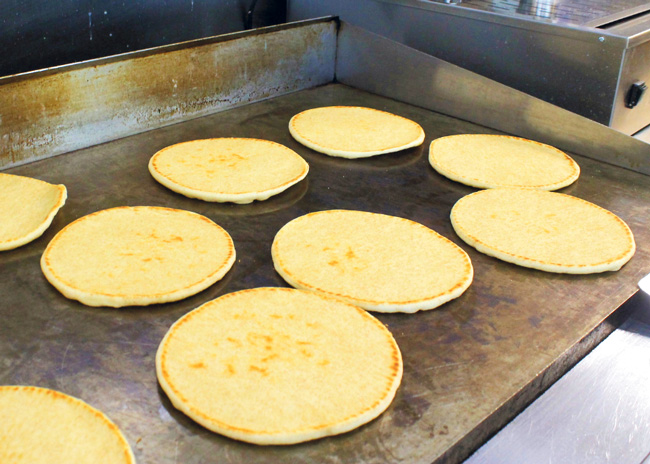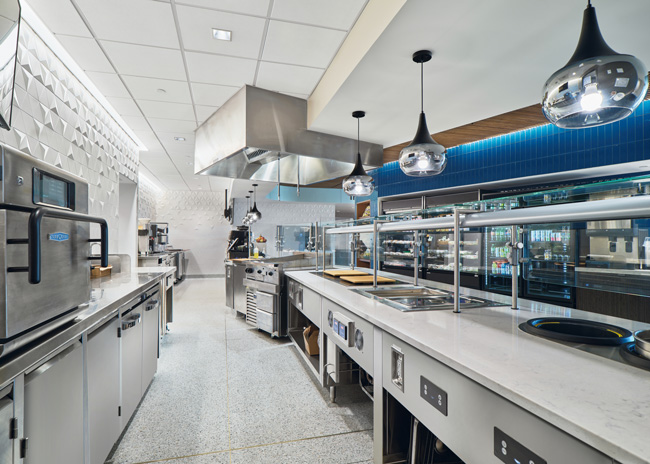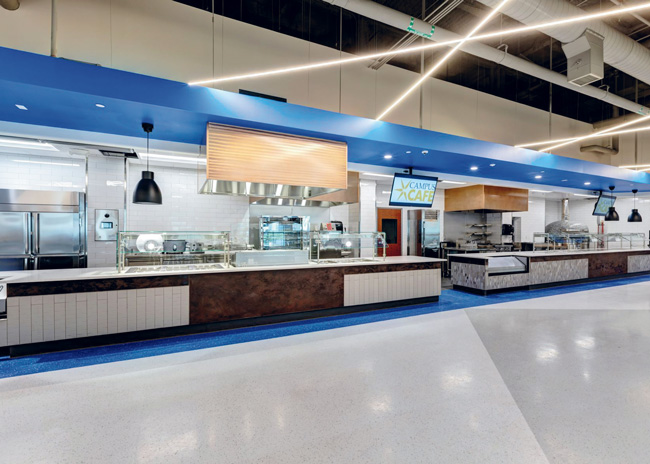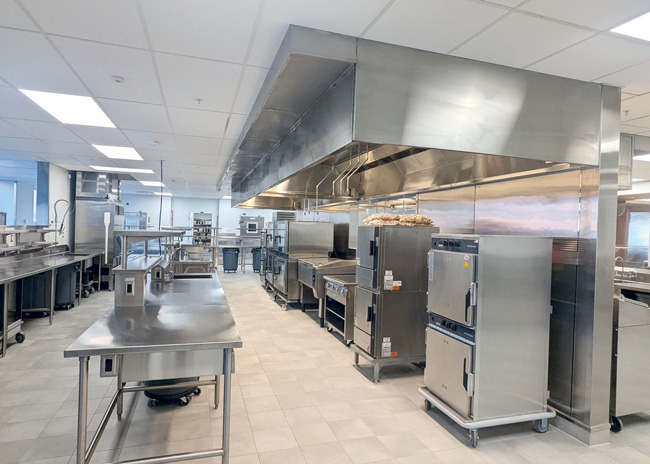Before it was a Mediterranean concept, Mezze Table at Georgia Gwinnett College in Lawrenceville, Ga., served Mexican fare using a different name. Yet, despite having vastly different menu items, there was no reason to change the equipment.
“We adapted the menu to the equipment, but almost everything we needed was already there,” says executive chef Leia Kent. “We were successful, since the equipment was flexible to accommodate different items.”
 Mezze Table’s grill station includes equipment specifically designated for cooking gyro meat. Photos courtesy of Aladdin Campus DininThis included a large clamshell grill for cooking chicken, a flattop to prepare gyro meat and a fryer, formerly used for making tortilla chips and now designated for pita chips. It didn’t hurt that Ibrahim Yildirim, Georgia Gwinnett College’s foodservice director, previously worked in Greek restaurants and knew this equipment would suffice.
Mezze Table’s grill station includes equipment specifically designated for cooking gyro meat. Photos courtesy of Aladdin Campus DininThis included a large clamshell grill for cooking chicken, a flattop to prepare gyro meat and a fryer, formerly used for making tortilla chips and now designated for pita chips. It didn’t hurt that Ibrahim Yildirim, Georgia Gwinnett College’s foodservice director, previously worked in Greek restaurants and knew this equipment would suffice.
“The key is to look at a dining space and food area and determine how to change it to another concept without a high cost,” Kent says. “Because schools are budget conscious, it’s important for us to be creative, think outside the box and repurpose equipment and spaces whenever possible.”
Why is flexibility so important? “Foodservice and dining trends are changing more rapidly than ever before,” says Kip Serfozo, design director, Cini-Little International, Germantown, Md.
 The flattop grill at Mezze Table at Georgia Gwinnett College serves double duty in preparing diverse menu items, such as meat and pita bread.Another aspect driving the need for flexibility is higher costs, including real estate and, in some cases, equipment. As a result, making major changes is often fiscally detrimental. Operators will continue to need to be able to accommodate meals at various times throughout the day too.
The flattop grill at Mezze Table at Georgia Gwinnett College serves double duty in preparing diverse menu items, such as meat and pita bread.Another aspect driving the need for flexibility is higher costs, including real estate and, in some cases, equipment. As a result, making major changes is often fiscally detrimental. Operators will continue to need to be able to accommodate meals at various times throughout the day too.
“The challenge is providing flexibility so a concept can navigate production during different day-parts and service modes,” says Juan Martinez, principal and co-founder, Profitality Labor Guru (PLG), Miami. “Customers are the same, but how they eat is different.”
In other words, the need for foodservice to be able to pivot quickly will not subside anytime soon. For this reason, designers must approach their projects with an open mind. “When we think about designing these spaces, we must be forward thinking,” says Rochelle Monahan, associate principal working in healthcare foodservice for Rippe Associates, Minneapolis. “Making designs flexible saves on costs and time by avoiding redesign work, construction and downtime. We can’t always anticipate the future, but we can at least try to design flexible spaces that can adapt as menus, service models and production techniques evolve.”
 Versatility with menus and equipment creates a win-win in foodservice operations.
Versatility with menus and equipment creates a win-win in foodservice operations.
Starting the Discussion
Flexibility should be a part of the conversation early on and throughout the design process. “We ask our clients to step outside of what they’re doing today and think about what they want to do in the near future and beyond,” Monahan says. “We want them to think big and imagine what they could do if they weren’t limited by the space or layout of their current foodservice areas.”
One of the most enjoyable parts of the process early on is the ideation or the “blue skies” conversations, notes Matthew Anderson, associate principal, Rippe Associates. “It’s exploring what could be and fostering a discussion around what they’ve seen or heard of, adding to what we’ve seen and done, and how that could be incorporated into their project,” he says.
When determining a facility size and volume, flexibility options should be part of the conversation. This will help identify options for cost savings as well as design, Serfozo says.
“We’re not designing for the past but for the future, and that’s when it becomes challenging,” Martinez says. “I tell clients to be in a continuous improvement mentality; whatever you do today may be good now, but I guarantee it’s not going to work tomorrow since consumers continue to change.”
Flexibility at the forefront results in a wide range of benefits for foodservice operators. Not only does it allow operators to change menus more rapidly, but they can alter the style of service to capture additional revenue. “Many times, operators are able to cut costs due to economies of scaled labor,” Serfozo says.
Enhanced flexibility also may lead to better physical and mental ergonomics for employees. “Team member comfort is key,” Martinez says. “When flexibility is enhanced for different dayparts, items and needs, sales and profits increase, and brands grow.”
When flexible foodservice designs focus on employees, this improves the customer experience and boosts revenue overall. “That overall experience can be leveraged in many ways, including staff recruitment and retention or sales and marketing,” Anderson notes.
When looking at flexibility, clearly defining what type of experience to offer and what that might look like in the future is a solid approach. “Understanding the ability to change direction, in short order, and creating a plan that works well over time are key,” Anderson says.
Flexible operations need to be intuitive from both the staff and customers’ perspectives. “Operators need to make it clear how customers use the space with dining and being served,” Serfozo says. “From an operator’s standpoint, it’s about proper training; if you’re changing an operation, you need to continually train on how the new system is working or flexing from doing something one way to doing it another way.”
Although looking ahead is necessary, project teams must resist looking too far down the road. “We don’t want to compromise the now because we’re so focused on the future,” Monahan says. “We have to think about how we balance current operations with the future.”
 Stations at the University of Cincinnati’s MarketPointe dining hall are designed to accommodate both high- and low-volume periods. Photo courtesy of Ryan Kurtz Photography
Stations at the University of Cincinnati’s MarketPointe dining hall are designed to accommodate both high- and low-volume periods. Photo courtesy of Ryan Kurtz Photography
Equipment & Design Considerations
Production concerns may arise as equipment, menus and concepts change over time. “We have to think about which pieces of equipment we can use that are versatile and can aid our clients in preparing and serving a variety of offerings,” Monahan says. “Because it can be challenging to add power, drains, water lines and data in the future, if we have utilities available from the start, it’s easy for clients to add or change equipment as needed.”
Questions to ask include what is currently happening in the space, and what might happen in the space in the future with production flow and equipment usage. Also, it’s important to determine how many people currently work in the kitchen and if this will change moving forward.
 Milwaukee Area Technical College’s servery equipment was intended to support a variety of menu changes. Photo courtesy of Scott Witte Photography“All of this influences the design, so understanding as much about the future as possible will be critical,” Anderson says.
Milwaukee Area Technical College’s servery equipment was intended to support a variety of menu changes. Photo courtesy of Scott Witte Photography“All of this influences the design, so understanding as much about the future as possible will be critical,” Anderson says.
Incorporating multiuse equipment, such as combi ovens, or units that expedite service like speed ovens, enhances menu flexibility, Serfozo says. Easy transport and plug-and-play units also come into play with these designs. “Casters and quick disconnects on equipment are important,” Serfozo says. “One of our clients utilized a mobile worktable with a heated shelf unit that’s powered by a dropped-cord receptacle. This allows it to be plugged in and wheeled anywhere it’s needed.”
Flexibility is all encompassing and comprises everything from the design concept to processes, procedures, staff deployment, equipment, technology and menu. “Operations need flexibility to accommodate both low- and high-volume periods,” Martinez says. “At low volume, most concepts lose their shirts and, if not careful, will deploy more people and equipment, then lose money. At high volume, operations may lose sales capacity.”
Most concepts spend the majority of time operating during low-volume, not peak, periods. While it’s easier to design for the latter, the design needs to work for both so as not to leave money on the table during busier times or erode profits during slower periods.
“B&I operations can build in mobile foodservice counters with concealed casters that can move around and create different service platforms,” Serfozo says.
It benefits both commercial and noncommercial facilities to be forward thinking and focus on flexibility during design. “In some noncommercial sites, like a hospital, the foodservice department is located deep within the building with other departments around it and perhaps several floors above,” Monahan notes. “It can be challenging to do significant renovation work, gain more space, add exhaust or rework utilities. In these instances, it’s even more critical to design with flexibility in mind.”
If the budget allows, incorporating pricier equipment that is more versatile can pay off over time. “Because equipment and technology are major investments, operators should see how it can be streamlined, and look at it from an investment perspective,” Martinez says. “This allows continued flexibility and growth.”
There also needs to be versatility in how information flows to ensure it is available at the right place and at the right time. “In technology and with AI, the growth is exponential,” Martinez says. “Operators need flexibility to write orders in different ways for various dayparts since there are different routings.”
 Incorporating equipment with casters enables Wells Fargo East Campus foodservice team to easily reformat the back of the house as needed. Photo by Karen Thompson
Incorporating equipment with casters enables Wells Fargo East Campus foodservice team to easily reformat the back of the house as needed. Photo by Karen Thompson
Implementing Innovations
In terms of flexibility, implementing newer technology makes things easier and harder at the same time. “As an example, we have hot/cold wells that can make serving lines very versatile without having to swap out large, heavy pieces of equipment. This makes life easier,” Monahan says. “On the flip side, technology is changing so quickly and adoption rates vary by market segment and geography, so it can be challenging to design something that works today and also works in 15 to 20 years without knowing what’s coming. In some cases, the technology used drastically changes the layout and the flow.”
Smaller equipment, plug-and-play units and transportable features go a long way in enhancing the flexibility of the back of house. “Shelving that is easily taken apart [helps create versatile storage areas], and it’s easier to change a prep line with tables that are 48 inches long or less,” Serfozo says. “We’re steering clear of big chef counters that are customized because, once built, it’s hard to change them out.”
Instead, Serfozo’s noticing kitchens with separate pieces that can be more easily reconfigured. “Some manufacturers offer cooking modules that can be changed out, such as a refrigerated base that can hold either a griddle or charbroiler,” Serfozo says. “We’re seeing more display cases that can hold hot, cold and ambient food displays so, if the mix changes, they can pivot. There are also smaller merchandisers that allow for future modifications or easy replacement.”



